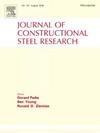利用合成数据对结构钢的 ULCF 寿命进行机器学习预测
IF 4
2区 工程技术
Q1 CONSTRUCTION & BUILDING TECHNOLOGY
引用次数: 0
摘要
机器学习(ML)已逐渐发展成为一种有效的疲劳寿命预测方法。然而,在昂贵的测试所产生的数据点稀缺的情况下,训练一个准确且稳健的 ML 模型具有挑战性。本研究提出并验证了使用表格生成式对抗网络(GAN)生成的合成超低循环疲劳(ULCF)寿命数据作为 ML 模型的输入。通过人工神经网络(ANN)和多保真度深度神经网络(MFDNN)使用合成数据对结构钢进行了超低循环疲劳寿命预测。结果表明,与仅使用原始实验数据训练的 ANN 模型相比,使用原始实验数据和合成数据训练的 ANN_Syn 模型在 ULCF 寿命预测中具有更高的 R2 平均值和更低的标准偏差。通过表格 GAN 利用合成数据率先构建的 MFDNN 模型总体上具有良好的预测性能。与 ANN_Syn 模型相比,合成数据的大小对 MFDNN 模型预测能力的影响更为显著。本研究的结果将促进 ML 模型在钢结构 ULCF 寿命预测中的应用,从而大大降低钢结构 ULCF 损伤评估模型参数标定的成本。本文章由计算机程序翻译,如有差异,请以英文原文为准。
Machine learning for ULCF life prediction of structural steels with synthetic data
Machine learning (ML) has gradually developed into an effective method for fatigue life prediction. However, training an accurate and robust ML model is challenging when the data points resulting from expensive tests are scarce. This study proposed and validated of using synthetic ultra-low cycle fatigue (ULCF) life data generated by tabular generative adversarial network (GAN) as input for ML models. The ULCF life prediction using synthetic data was conducted for structural steels through artificial neural network (ANN) and multi-fidelity deep neural network (MFDNN). The results demonstrated that the ANN_Syn model trained with original experimental data plus synthetic data possessed higher mean value and lower standard deviation of R2 in ULCF life prediction, compared to the ANN model trained with original experimental data only. The pioneeringly constructed MFDNN model with synthetic data by tabular GAN can generally have good predictive performance. The synthetic data size had more significant influence on the predictive ability of MFDNN model than that of ANN_Syn model. The results of this study will promote the application of ML models on ULCF life prediction of structural steels, thereby greatly reducing the cost of parameters calibration of models for ULCF damage evaluation of steel structures.
求助全文
通过发布文献求助,成功后即可免费获取论文全文。
去求助
来源期刊

Journal of Constructional Steel Research
工程技术-工程:土木
CiteScore
7.90
自引率
19.50%
发文量
550
审稿时长
46 days
期刊介绍:
The Journal of Constructional Steel Research provides an international forum for the presentation and discussion of the latest developments in structural steel research and their applications. It is aimed not only at researchers but also at those likely to be most affected by research results, i.e. designers and fabricators. Original papers of a high standard dealing with all aspects of steel research including theoretical and experimental research on elements, assemblages, connection and material properties are considered for publication.
 求助内容:
求助内容: 应助结果提醒方式:
应助结果提醒方式:


